Nürnberg-München high speed line
Posted: 2 March 2005 | | No comments yet
The Nürnberg-München line via Ingolstadt was entered in the Federal Transport Infrastructure Plan in 1985. The regional planning procedure got underway in July 1989 and in May 1992 the statutory public enquiry for the new-build project was initiated by what was then still Deutsche Bundesbahn. As from 1994, DB Netz AG took this work on.
The Nürnberg-München line via Ingolstadt was entered in the Federal Transport Infrastructure Plan in 1985. The regional planning procedure got underway in July 1989 and in May 1992 the statutory public enquiry for the new-build project was initiated by what was then still Deutsche Bundesbahn. As from 1994, DB Netz AG took this work on.
The Nürnberg-München line via Ingolstadt was entered in the Federal Transport Infrastructure Plan in 1985. The regional planning procedure got underway in July 1989 and in May 1992 the statutory public enquiry for the new-build project was initiated by what was then still Deutsche Bundesbahn. As from 1994, DB Netz AG took this work on.
A financing agreement for the Nürnberg-Ingolstadt-München project was signed between the Federal Transport and Finance Ministries and DB AG on 19th December 1996. Funding for the concurrently built stretch of urban rapid transit line from Dachau to Obermenzing, between Ingolstadt and München, was agreed between the Federal Land of Bavaria and DB AG on 28th December 1998.
Netz 21 scheme
Competition on rail is crucially dependent on a high-performing, cost-effective track system. A key contribution to this is being made by the Netz 21 scheme embracing restructuring, standardisation, segregation/harmonisation of traffic types, elimination of bottlenecks, use of new technologies and the full harnessing of traffic potential. In the process, the scheme is also designed to achieve the Rail Reform goal of ‘transferring more traffic to rail’.
Netz 21 is a conclusive overall strategy comprising three packages that directly intermesh and build upon one another.
First Package:
- Optimising the existing network
- Raising the level of replacement investment
- Segregating and harmonising traffic types
Second Package:
- Leading-edge command/control systems
Third Package:
- New-build and upgraded lines with a high network effect
Its goals are:
- To move more traffic to rail by offering adequate capacity as and when required, enabling carriers to deliver competitive timings, and ensuring a high level of facility availability
- To make major cuts in the cost of operating the network so as to offset rising levels of depreciation, amortisation and interest as well as the phasing-out of grants for inherited burdens
- To make for stable train path prices
- To allow balanced operating results to be achieved
- To be implemented and fundable by 2010
The scheme’s success depends on the various measures and packages of measures being put to effect quickly, in an integrated manner and, where possible, for complete corridors.
Measures are planned in corridors with defined study areas. The long-term objectives involve:
- Coherently gauging all infrastructure investment made in the corridor
- Investing good effect in the track, i.e. so as to yield the greatest possible increase in demand
- Defining the corporate target network
The Nürnberg-Ingolstadt-München new-build/upgraded line plays a leading part in the Netz 21 scheme, because it:
- Enables journey times to be cut to as little as a very competitive three hours, notably on the Frankfurt-Nürnberg-München corridor
- Accordingly constitutes a key sub-section of what is now the fastest link from Western Germany and the Rhine/Main region to München
- Allows the segregation concept to be put into practice along the Würzburg-Nürnberg-München corridor by routing fast traffic from Würzburg to München primarily via Nürnberg and Ingolstadt and slower traffic primarily via Treuchtlingen and Augsburg. As well as representing a major step towards segregating traffic types on the DB AG network, this is also a key prerequisite for enhancing the quality of rail freight traffic in Southern Germany in particular.
The Nürnberg-Ingolstadt-München new-build/upgrade project
The overall project involves 171km of line. It embraces the 89km new-build section from Nürnberg to Ingolstadt and the 82km upgrade section from Ingolstadt to München. The line forms part of the European high speed link from Scandinavia via Berlin and München to Verona. This North-South link project has enjoyed priority status in the EU’s ‘Trans-European Networks’ programme since 1994.
The new-build section starts roughly 6km south east of Nürnberg’s central station and ends south of the bridge over the Danube just before the central station at Ingolstadt. It is laid out for speeds of 300km/h throughout and features a maximum gradient of 1 in 50. It is designed for both passenger and freight traffic.
The philosophy of ‘bundling traffic flows’ was rigorously adhered to when planning the new-build line. Between Nürnberg and Ingolstadt the line largely runs alongside and in close proximity to the A9 motorway (Figure 1).
The Ingolstadt-München upgrade section begins at Ingolstadt’s central station and ends at München-Obermenzing, roughly 7km north of the central railway station in München. Speeds of between 160 and 200km/h will be possible on this upgraded stretch of line in the future, which features a maximum gradient of 1 in 80.
In the course of upgrading the line, the München urban rapid transit service to Ingolstadt is being increased to a 10 minute frequency. From the München URT Line 2 terminus at Petershausen station, extra capacity has been created in a southern direction by means of a third or fourth track (Figure 2). This will enable long-distance, regional and freight traffic to be kept apart from URT traffic in the future.
The construction contract
Construction orders were awarded as separate all-inclusive contracts in six sections to a single general contractor respectively.
Construction lots for the new-build section (km readings from Nürnberg to Ingolstadt):
- Fischbach-Feucht – 5,900-13,630
- Northern lot – 13,630-48,650
- Central lot – 48,650-67,000
- Southern lot – 67,000-84,600
- Audi tunnel – 84,600-86,253
- Ingolstadt node – 86,253-88,562
The lineside equipment for the entire new-build section was combined to form the Technical Equipment lot.
There are three construction lots (sections) for the upgraded portion of line, where construction orders also include most of the technical equipment.
Construction lots for the upgraded line (km readings from München to Ingolstadt):
- Northern lot – 38,630-74,323
- Central lot – 18,664-38,630
- Southern lot – 4,900-18,664
Engineering the new-build line
The new-build line from Nürnberg to Ingolstadt traverses the Southern Franconian Alps, rising from 330m to 500m above sea level, then dropping back down to 370m above sea level in the Danube basin. Given the tightly formulated criteria for the layout of a line designed for both passengers and freight services, a large number of engineering structures are entailed.
Tunnels
In all, there are nine tunnels with an overall length of approximately 27km to be built on this section of route. The longest are in the central section of line, specifically the 7,700m Euerwang tunnel and the 7,260m Irlahüll tunnel. The three tunnel structures Offenbau, Denkendorf and the Audi tunnel near Ingolstadt were originally conceived as cut-and-cover projects, the others as bored structures. The Audi tunnel was driven under compressed air in accordance with a special proposal by the bidding group that foresaw working underground beneath a top cover.
The excavation technique for the bored structures conventionally drew on the principles of the New Austrian Tunnelling Method owing to the pronounced geological variations obtaining and the resultantly thin covering layer in places. With this method, the structure is first provisionally secured by means of an outer shotcrete shell and then, in a separate process, the final inner shell is put in place using in-situ concrete.
The tunnels, in the northern section, pass through a variety of sandy-to-clayey sandstone formations. As from the mountain ascent southwards, they lie in predominantly karstified limestone rock.
At two places it proved necessary to run the line beneath the A9 motorway (Figure 3). The underpasses were built adopting elaborate safety measures with protection from a tube screen, and the work was accomplished without any major hitches.
Tunnel driving operations through the karst rock had to be conducted with great care and skill. At times spectacular cave systems were encountered that could only be traversed in small stages with very short face-cutting depths. Numerous precautions had to be taken when performing the work (e.g. face anchors, tube screens, exploratory drilling etc.). Tunnelling was accompanied by an exhaustive short-interval measuring process. The rock was carefully examined and densely filled or plugged before the inner shell was erected. Intensive observation of the rock’s deformation behaviour continued once the inner shell had been inserted.
Here follows a brief account of each of the main tunnels and earthworks, listed from north to south.
Offenbau tunnel
Offenbau tunnel lies in tertiary and quaternary deposits of opaline clay, a material that contains aquiferous fissures. The argillaceous overlays create an overhead seal, with the result that ground water with a high ‘surface tension’ is to be found here.
It was envisaged using cut-and-cover and some lined excavation to build the tunnel, and this is how the venture was planned and commenced. During digging to produce the bottom of the tunnel, however, incidents of talus slide occurred and there were the first inexplicable manifestations of subsidence.
The ensuing follow-up reconnaissance was specifically geared towards such phenomena and established a clear link with the ground water. Any drop in piezometric levels due to the water table being lowered could have triggered uncontrolled subsidence in the neighbouring locality of Offenbau, and hence it was imperative that the venture be replanned to take account of the geological and hydrological characteristics identified.
It was decided to work underground making use of a top cover and rows of bored piles (Figure 4), the tunnel being excavated beneath the cover in a protective compressed-air environment. There was no need to lower the surface tension of the ground water with this method.
Euerwang tunnel
Euerwang tunnel passes through ferruginous sandstone, a greyish-black, moderately hard sandstone formation of a sandy or argillaceous nature. The tunnel was conceived as a drained structure with continuous discharge of a given amount of mountain water, with greater influxes of water being displaced by means of injections.
During driving, it transpired that the total volume of mountain water was higher than had been forecast and that, instead of being primarily focussed on fissures, influxes of water were diffusely disseminated over the entire sandstone matrix. This rendered the concept of displacing water by means of injections inoperable.
The technical solution to this problem involved switching to a system of all-round sealing of the tunnel using pressurised water and gauging the water pressure.
Irlahüll tunnel
The southern stretch of Irlahüll tunnel traverses the karstic limestones of the Jura Mountains. Exploratory drilling indicated that the tunnel would lie in rock containing fissures that were corrosively enlarged due to karst phenomena. In the course of driving, however, several complex cave systems were encountered, some negotiable. For safety reasons, an infill concept involving concrete plugs and injections was devised and put to effect.
Bridges
A total of seven viaducts had to be erected along the new-build line. In the northern construction lot, 48 bridge structures were built, 30 of them railway bridges – some with open and some with ballasted floors – and 18 road bridges. The longest, which measures 305m overall, takes the St. 2227 main road over the A9 motorway, the ICE railway line and the river Schwarzach.
Slabtrack
To permit high-quality, cost-effective use of the Nürnberg-Ingolstadt-München new-build/ upgraded line as part of the Trans-European Transport Network (TEN), the track for the Nürnberg-Ingolstadt new-build section is being designed for speeds of 300km/h by installing ‘slabtrack’.
A total of 75,100km of line is being fitted with slabtrack. In the process, a total of three different systems of slab track are being used:
‘Rheda Classic’ system
This track is being fitted along 2,000km in the Audi tunnel and approaching Ingolstadt. Construction here is by means of non-reinforced concrete troughs together with monoblock sleepers and infill concrete. Reinforced steel is exclusively used in the infill concrete to confine crack width and earthing. At some points within the tunnel a sprung mass system was inserted beneath the trough. The trough’s cheeks are reinforced here.
Rheda 2000 system
Approved by Germany’s regulatory body, the Federal Railway Office (EBA) since April 2000, this track system is a further development of the Rheda Classic system (Figure 5). Rheda 2000 is being fitted along 38,100km of line in the Fischbach-Feucht lot and the Central and Southern new-build line lots. This design features a B 35 reinforced concrete bearer slab 24cm thick and 3.20m wide with unimpeded crack formation on a 30cm hydraulically bonded base layer with integral B 355.3 W 60 M Type prefabricated bi-block sleepers.
Bögl slab track system
This track type is being installed on 35.000km of line in the Northern new-build line lot. A prefabricated slab 20cm thick, 6.45m long and 2.55m wide and made of C45/55 (B 55) concrete is laid on top of a 30cm hydraulically bonded base layer that is continuously coupled along the longitudinal axis, with rail supports being placed on bottom cast mortar applied subsequently. A key feature of the system is the works-produced and individually engraved geometry at the rail support point. The slabs are coupled together longitudinally (by means of six DN 20 threaded steel rods). The slab is prestressed in the transverse direction.
All the slab tracks for the Nürnberg-Ingolstadt new-build line will be in place by spring 2005.
The upgraded line
The engineering works for the upgraded line are being carried out under normal operating conditions, i.e. with over 200 trains passing each way each day (Figure 6).
A large number of bridges and underpasses have to be adapted, barrier level-crossings removed and tracks added to those already in place. Line improvements and modernisation of the command/control technology make for shorter journey times. The 13 existing passenger stations and URT stopping points are being fitted with barrier-free platform access points and in many instances additionally with P&R facilities. A new URT stopping point is being built at München-Untermenzing.
Command/control systems
Command/control systems include both signal boxes and automatic train control systems.
Electronic signalling installations (ESTWs) are being installed on the new-build section of line instead of old-style relay systems. An ESTW subcentre was built at Fischbach station back in 1993 and is now being geared up for the Nürnberg-Ingolstadt new-build line. There are local modules at Allersberg and Kinding stations as well as near Lohen.
Subcentres are being installed for the upgrade section at Ingolstadt Nord and Petershausen stations. It is envisaged the local modules will be situated at Rohrbach and Röhrmoos stations. The ESTW units are operated from the Traffic Management Centre in München.
LZB, an electronic means of effecting continuous automatic train-running control, is being put in place along the entire line for trains with speeds of over 160km. With this system, data is exchanged between an on-board computer and radio block centres via a conductor cable run along the centre of the track. The train driver receives information in this way regarding distance to target, authorised speed and signals to be expected ahead for up to the next 10km.
Outlook
The Nürnberg-Ingolstadt-München new-build/upgraded line is entering service on 28th May 2006 – on cue for the start of the Football World Cup 2006 in Germany.
The Nürnberg-Ingolstadt-München line is playing a key part in a process which, with the change of timetable in December 2006 and the completion of further major rail projects (e.g. the Berlin node North-South link) will usher in a completely new quality of high speed and long-distance rail passenger travel in Germany whose innovative impact will be virtually on par with that felt when the ICE services were inaugurated in 1992.
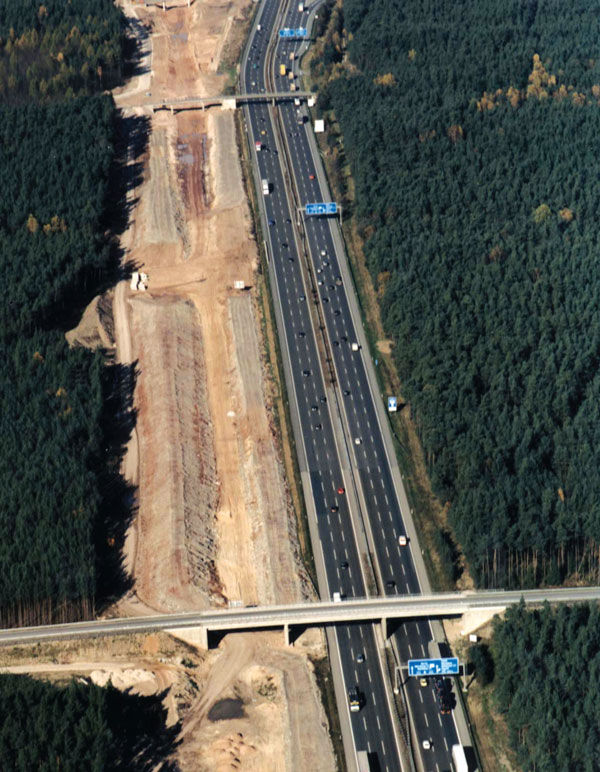

Figure 1: Aerial shot of the Nurnberg-Ingolstadt new-build line running alongside the A9 motorway
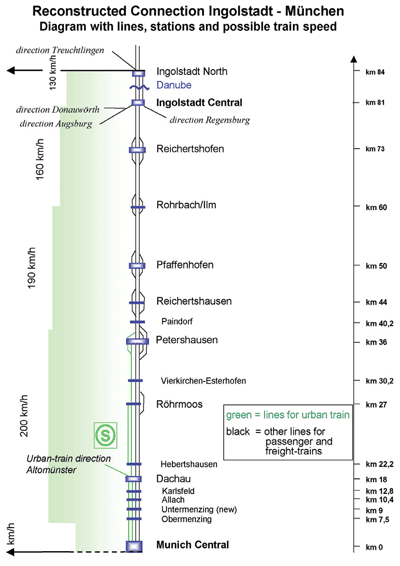

Figure 2: Route diagram
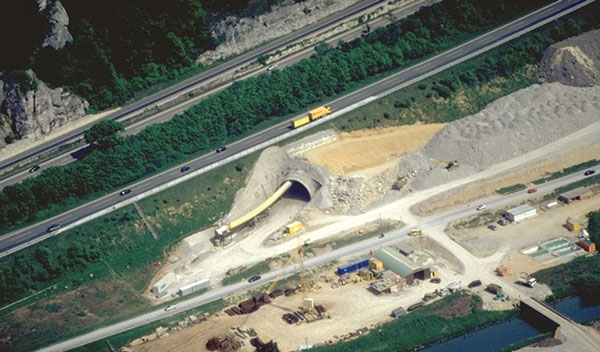

Figure 3: Irlahull north portal where the line passes under the A9 motorway
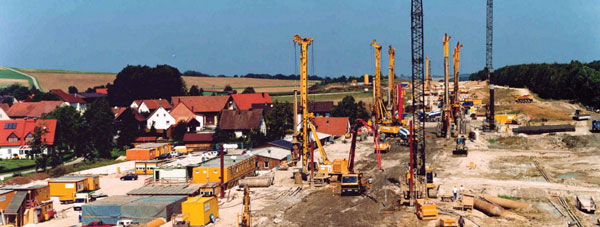

Figure 4: Bored piling work at Offenbau tunnel
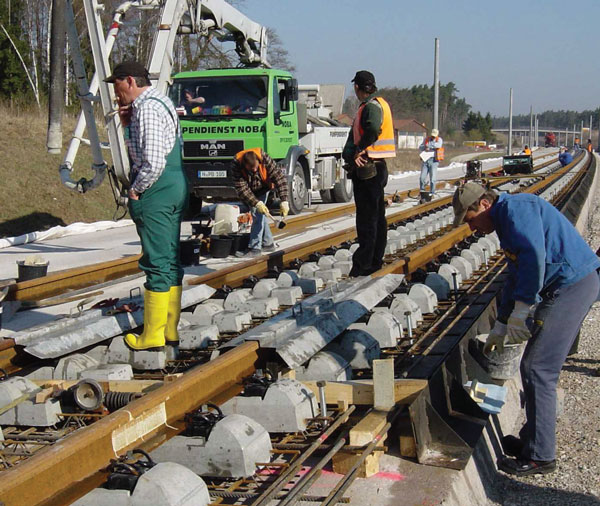

Figure 5: Rheda 2000 slab track
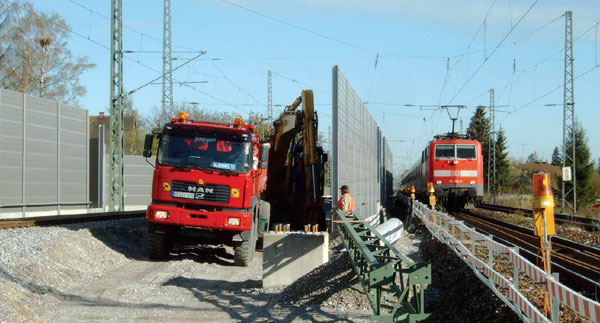

Figure 6: Construction under normal operating conditions








